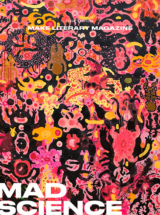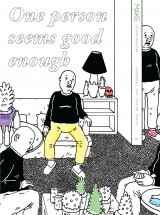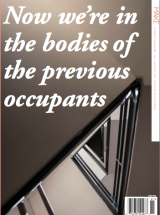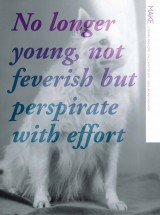Eula Biss Interviewed
Comments Off on Eula Biss InterviewedAuthor Eula Biss’s second book, Notes from No Man’s Land: American Essays, is a winner of the Graywolf Press Nonfiction Prize and the National Book Critics Circle Award for Criticism. And after the publication of her first book, The Balloonists, as well as Notes from No Man’s Land, her success continues with On Immunity: An Inoculation . What I love most about Biss’s writing, the reason I’ve reached out to her here, is her ability to synthesize the personal and the factual, giving the reader both insight and a learning experience at once.
Biss has earned a reputation as a prominent writer of literary nonfiction and cultural criticism, and her writing, as with the writing of many skilled essayists, continues to pose questions that might be as difficult to ask as they are to answer. In On Immunity, for instance, she interrogates the subject of medicine and its relationship to race, class, and gender, and urges us to think about health and its ties to our privilege. Much like the work of Susan Sontag, Leslie Jamison, Maggie Nelson, and James Baldwin, Biss’s work encourages reflexivity—we begin to think, after reading it, about the ways we might reposition ourselves in front of a subject.
Micah McCrary (MM): How do you imagine a reader with no familiarity with your prior work might encounter On Immunity?
Eula Biss (EB): On Immunity extends some of the thinking that I was doing in Notes from No Man’s Land, but I didn’t intend it to be a continuation of that book or a sequel. When I began writing On Immunity I was excited to be working on something that felt very different from my last book—and at first glance the subject matter and the style and the formal approach of On Immunity are all quite distinct from Notes. I already knew, before I began writing On Immunity, that health care is one of the arenas in which racism manifests, but I was still a bit surprised to find that many of the issues of race and class that I’d been thinking about in Notes reappeared in this new context. (I had the sense that racism was chasing me, that I couldn’t get away from it, which may sound familiar to anyone who is intimately acquainted with racism—it’s everywhere.) I think the way those issues of race and class present themselves in this book might surprise some readers as well, but less so if they’ve read my last book. Notes introduced some questions about privilege and responsibility that On Immunity explores more specifically in the context of public health.
MM: What was the strongest impetus for actually startingto write this book? Where does On Immunity begin for you?
EB: My research began when I was pregnant with my son, long before I imagined that I would write a book [about these topics]. I read and researched for several years before I started writing. At first I imagined I would write an essay about vaccination, but as I continued to read and the issue continued to branch in new directions I realized that the essay would have to be a long essay. I suppose that’s where the book really began—in between the research and the writing, when I was so overwhelmed with the enormity of the subject that I knew it would demand a work of some length.
MM: It’s interesting that you perceive a space between research and writing, while many writers seem to view them as adjacent or even successive.
EB: Well, it’s much more typical for my research to be embedded in my writing, for me to be writing in response to research but also researching in response to what I have written. With this book, I spent an unusual amount of time researching before I began writing. I do think of one stage, in this case, being a research stage and the next stage being a writing stage, though I continued to research as I wrote. I researched for a couple years or so before I began writing in earnest, and then I wrote much faster than I usually write. When I write shorter essays, I very often put something on the page before I turn to research to drive me further into my subject. But the relationship between research and writing changes, I’ve found, from project to project.
MM: At what point in your research did you discover that myth, metaphor, and medicine intersected? Or was this something you understood before you began the process of writing?
EB: I began noticing metaphors at work as soon as I started reading about vaccination. I also noticed that the term “myth” was frequently used to describe erroneous ideas about vaccination. That term wasn’t meant to evoke the Greek myths that my mother read to me as a child, but that’s what happened. The term prompted me to search my memory for myths that could serve as metaphors for vaccination, myths that might reveal rather than conceal truths about immunity. That process led me to the myth of Achilles, which is where I begin the book, and the myth of Narcissus, which is where I end the book. Those myths serve as cautionary tales and calls to moral action.
MM: On Immunity has an interesting tie to the popular culture of vampires. How did you discover that vampires—or Dracula, even—would become a part of your writing here? Was it from becoming a new mother?
EB: Vampires were very interesting to me as a new mother, and I found myself drawn to vampire stories immediately after my son’s birth, but I didn’t anticipate that vampires would become part of this book until I read Bodily Matters, a history of the anti-vaccination movement in Victorian England in which vampires appear as a metaphor used by anti-vaccination activists. This inspired me to investigate the vampire literature of the time, which led me to read Bram Stoker’s Dracula. It’s a fascinating book—melodramatic, yes, but also formally inventive and rich with metaphor. And in that book, Dracula is a metaphor for disease, not vaccination.
MM: In your notes for On Immunity, you mention being heavily influenced by Susan Sontag. Did you have similarly heavy influences on The Balloonists and Notes from No Man’s Land?
EB: On Immunity is, among other things, an extended conversation with Susan Sontag. Notes from No Man’s Land contains an essay, “Goodbye to All That,” that is very explicitly fashioned as an extended conversation with Joan Didion, but much of the rest of the book also engages Didion’s concern with narrative—particularly the failures of conventionally accepted narratives.
MM: On Immunity is tonally a bit different from your first two books. How have you viewed the trajectory of your work, regarding the way you present your writer’s voice?
EB: It may be tempting now that I have three books to try to construct a trajectory or a narrative of some sort out of their differences, but I’m not convinced that any such narrative is really there. Yes, there may be a loose trajectory of maturity in my work—I’ve been growing older as I write and I’ve been gaining new skills as a writer, but that doesn’t fully account for the differences between my books. The tone and approach of each book is determined as I write, by the demands of the project. I don’t begin a book knowing what I’m going to sound like, or even what I’m going to say. The process of essaying, for me, is an exploration. I’m often surprised and sometimes puzzled by where each new project takes me as a writer.
The tone of On Immunity was not something I anticipated before I began writing. It’s a bit grander and more elevated, a bit more influenced by Sontag perhaps, than Notes. In retrospect, that makes sense to me—in On Immunity I’m writing against a variety of sexism that trivializes issues that are important to women. Part of the project was to elevate and honor a conversation between women, and to illuminate the intellectual work of mothering. I also wanted to assert a feminism in which women get to know and feel, to have minds and bodies, to be both modern and ancient. That pushed the form of the book, which moves between sections that are dominated by information and sections that are highly personal, sections that are concerned with philosophy and sections that are concerned with the workings of the body, sections that are historical and sections that are speaking to the present moment.
MM: A feminism?
EB: Yes, because feminism is plural, composed of many feminisms. Even when we’re talking about the feminist movement, we’re talking about many movements, many generations, many waves, many modes of resistance. I’m grateful for the multiple feminisms that have fed my feminism, including, to name just a few, Betty Friedan’s The Feminine Mystique, John Berger’s Ways of Seeing, Carolyn Heilbrun’s Writing a Woman’s Life, Donna Haraway’s “A Cyborg Manifesto,” Barbara Ehrenreich’s The Hearts of Men, and Rebecca Solnit’s Men Explain Things to Me. Some of these feminisms draw on each other, talk to each other, critique each other, and contradict each other. That’s what keeps feminism dynamic and relevant.
Roxane Gay reminds us with her title Bad Feminist that when feminism is understood as a set doctrine or a circumscribed set of beliefs, then we run the risk of losing the heretics and dissenters that keep it vital. The irreverent feminism of “A Cyborg Manifesto” remains thrilling to me in part because it refuses polarities in which one quality or quantity is marked as bad and the other good, refuses to pit natural against unnatural, human against machine, woman against man, and insists instead that we are all cyborgs. It’s a feminism that informed my writing about race—a feminism that understands the relationship between different sorts of oppression. I was moved and changed by The Hearts of Men, which explores how a feminism that fails to liberate men can fail to liberate women. I believe and support that critique—in my home and outside of it—but I’ve also written a book in which I chose to address mothers directly, not fathers or anyone else. There may seem to be a contradiction there, but I don’t see it that way. I think these two feminisms can happily coexist, and that the project of one does not exclude the project of the other.
MM: Although, as you’ve said, part of the project’s objective is to “elevate and honor a conversation between women,” what’s your hope for male readers of this book? Or more particularly, for the fathers who read it?
EB: I would hope that men, fathers or not, could benefit from witnessing a conversation between women, and could find many of their own concerns reflected there. Women readers have lots of opportunities to practice the art of reading our own concerns into literature that is explicitly or implicitly presented as a conversation between men, and we are accustomed to finding ways to see ourselves in characters that are written as men. When a man writes a book in which he seems to be addressing other men, readers are often expected to understand this as one way of addressing all humankind. But when a woman writes a book in which she seems to be addressing other women, people start fretting that men will be alienated. Isn’t one of the essential lessons of literature the ability to find yourself in someone who doesn’t resemble you, and to find your life in a life that doesn’t resemble yours? Isn’t this why I keep reading “Notes of A Native Son,” over and over? And isn’t this why my son remains interested in The Wonderful Wizard of Oz? What I want to offer male readers is what I want to offer female readers, and readers who fall between genders—a meditation on vulnerability, the story of a quest for knowledge, an exploration of our interdependence, and a feminism.
MM: The book’s subtitle is “An Inoculation,” and it seems you found the word inoculate while looking for synonyms for protect. What are you trying to protect your readers from?
EB: I came to the word “inoculation” long before I looked up synonyms for “protect” and found it there as well—it’s the most inclusive term for various strategies of protection from disease, including vaccination and variolation, but it can also be used to describe any instance in which a microorganism is introduced into a human body. I was attracted to “An Inoculation” as a subtitle in part because one of the broadest meanings of “inoculation” is “to join or unite.” I wanted to join and unite concepts that had become polarized. But yes, I also wanted to protect the reader from unchecked, under-examined fear. This protection involved, like inoculation, introducing small amounts of that fear to the reader.
MM: When discussing race and vaccination, you often focus on the idea of a collective consciousness. What draws you toward thinking and writing about the collective?
EB: Yes, it is a refrain for me, a point of return, and I’m not sure that I can explain why I’m drawn to thinking about the collective, other than that I’ve always understood myself as part of a collective. I come from a big family that became, as I grew up, even bigger and more diverse. Being part of my family taught me, in many ways, how to be part of a community. And being part of a community, various communities, has shaped both my politics and my aesthetics.
MM: What ground doesn’t this book cover that you would’ve liked to, had you taken more time with the project or given it more length?
EB: Oh, I think there’s more to say on every single subject this book touches. But one particularly essential area is the international politics of vaccination. Another book could be written there—the history of vaccine testing and development in poor countries, the ways in which vaccine decisions made for a US market affect international access to vaccines, the ethics of who “pays” for vaccines, both in terms of money and risk. Time and the restrictions of my form didn’t allow for this, but I would have liked to investigate the international implications of the rotavirus vaccine that was taken off the market because it caused a serious complication called intussuseption in one out of every 10,000 doses. That incidence was unacceptable in this country, where deaths from rotavirus are relatively rare. But the cost benefit equation for that vaccine would look different in many African countries where deaths from rotavirus are common. In some places, the total incidence of intussuseption (which is also a complication of natural infection with rotavirus) would be greatly reduced, rather than elevated by widespread vaccination. I talked about this with a bioethicist who pointed out that our penchant for safety in this country very likely cost many African children their lives—when the vaccine was taken off the market here it also became unavailable in Africa. So, there’s a real flaw in our system.
MM: Is there a certain way you’ve come to see yourself as a writer? I’m thinking here about the ways a writer of fiction might identify more with the short story than the novel, or vise versa, and I’m wondering whether you feel more intrinsically tied to shorter essays or to longer ones.
EB: In On Becoming a Novelist, John Gardner suggests that writers are like runners and that some of us are sprinters and some are marathoners. I don’t know if that’s true, but I have thought of myself, for most of my career, as a short form writer. With some stretching, I can train myself into a longer form, as I did with On Immunity, but that is much harder for me than short form writing. This may change. A decade ago, I was still writing some prose poetry that was no longer than 500 words. Now, I like more room than that. I’ve recently been offered a couple op-ed assignments that felt too restrictive at 800 words. Perhaps I will eventually find myself comfortable in the long form. I like to think that I still have a lot of time left as a writer.
MM: How does your subject affect your way of writing? You’ve said elsewhere that you want your next book to be more lyric, perhaps more like The Balloonists. I’m interested in your decision-making process when it comes to style and form.
EB: I know writers who work form-first, meaning that they decide on a form and write into it, but I don’t tend to work that way. I find both my form and my style as I muddle my way through my early drafts. It happens gradually, and involves some intuition and some trial and error as well as some overt decision-making. The subject makes demands on form and style, and so do my desires.
In writing On Immunity, I was drawn to ideas and I looked for an approach that would allow me to dwell in ideas. The ideas are explored and illustrated in various ways—through personal narrative, through historical overview, through meditative moments—but the shape and structure of the book, how it is organized, is driven almost exclusively by the movement from one idea to another. I was working with a lot of information in On Immunity, and the information was not decorative—I didn’t have the luxury of allowing the information to lose its informative quality. There are places where this inhibited my lyricism. Eventually, I came to recognize that the lyricism in this book resides less in the line than it does in the movement from one idea to another, in the returns and refrains and the revelations that I found in the information. Nevertheless, it left me hungry for a different sort of lyricism. That’s why I said I wanted to return to that kind of writing in my next book, but I don’t know, really, what will happen next.
Eula Biss is the author of three books: On Immunity: An Inoculation, Notes from No Man’s Land: American Essays, and The Balloonists. Her work has been supported by a Guggenheim Fellowship, a Howard Foundation Fellowship, an NEA Literature Fellowship, and a Jaffe Writers’ Award. She holds a B.A. in nonfiction writing from Hampshire College and a MFA in nonfiction writing from the University of Iowa. Her essays have recently appeared in The Best American Nonrequired Reading and the Touchstone Anthology of Contemporary Nonfiction as well as in The Believer, Gulf Coast, Denver Quarterly, Third Coast, and Harper’s. Eula Biss and John Bresland are the Chicago-based band STET Everything.
Micah McCrary is a contributor to Bookslut and The Nervous Breakdown. His essays, reviews, and translations have appeared in the Los Angeles Review of Books, MAKE, Circumference, Identity Theory, Third Coast, Midwestern Gothic, The Essay Review, HTMLGIANT, and South Loop Review, among other publications. Former Assistant Editor at Hotel Amerika, he is a doctoral student in English at Ohio University and holds an MFA in Nonfiction from Columbia College Chicago.

















